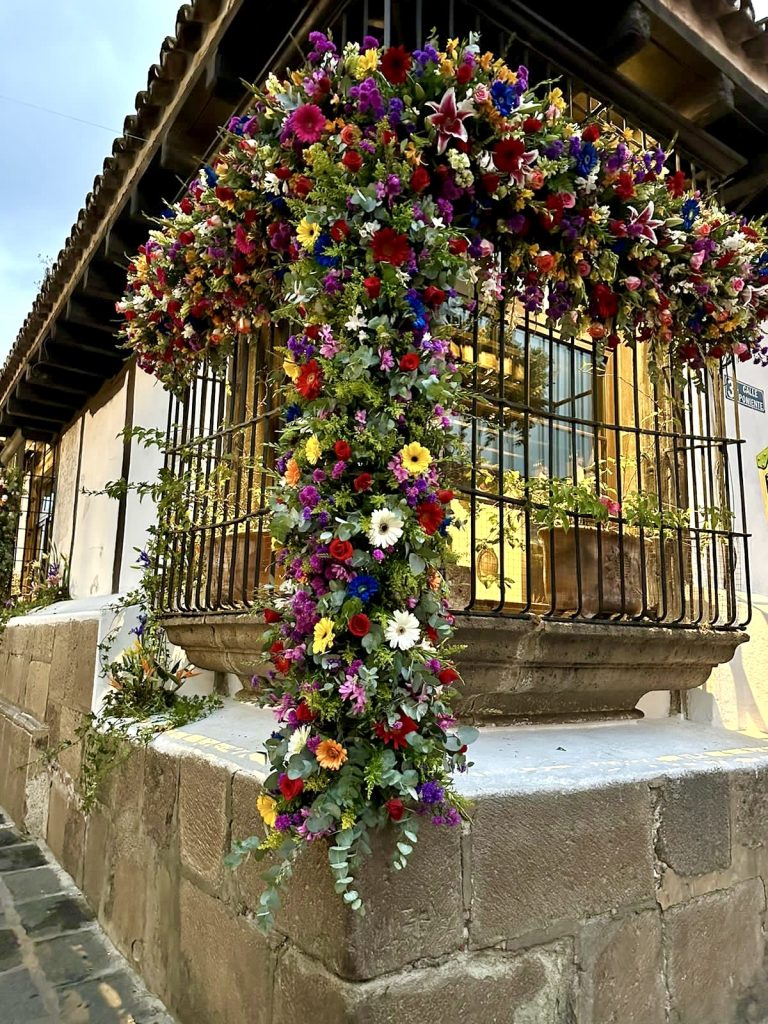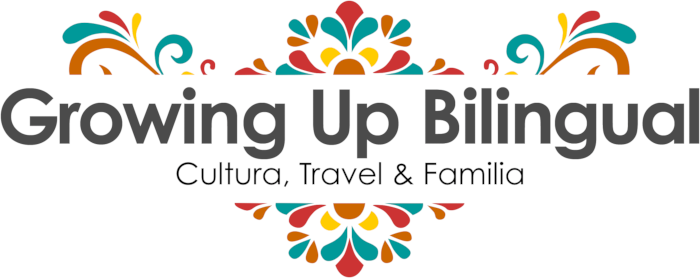In this article, we will explore the rich history and cultural significance of Semana Santa in Guatemala. I will share all about the famous sawdust carpets and the significance and main elements of the processions in Antigua Guatemala and the rest of the country.
Semana Santa, also known as Holy Week, holds great importance and is widely celebrated in Guatemala. This week-long event is a time for religious contemplation and also an opportunity to display the country’s vibrant cultural heritage. Semana Santa has been observed for centuries. These Guatemalan Easter traditions are deeply rooted in the social fabric of Guatemala.
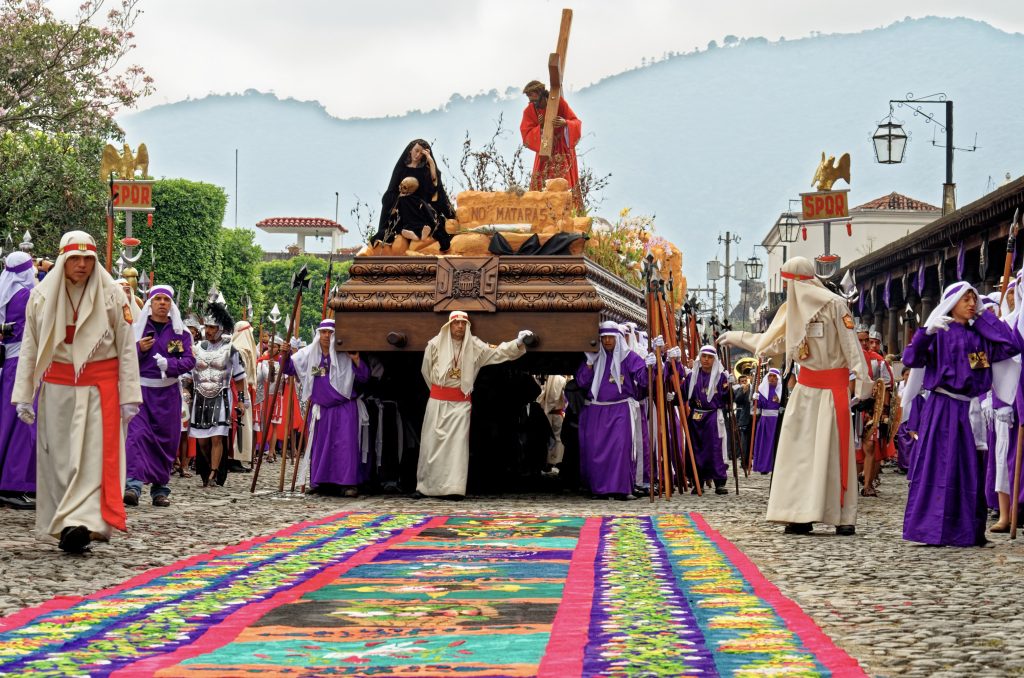
Whether you’re curious about this Guatemalan tradition or planning a visit Antigua Guatemala for Easter, or if you’ve witnessed the processions and are seeking the meaning of some of the traditions, you’ll find information here. This article will explore the origins of Semana Santa traditions in Guatemala and how they have evolved over time. I will also share in depth information about the main elements of Semana Santa traditions and how they are a significant part of the country’s cultural and religious identity.
History of Semana Santa Traditions in Guatemala
Semana Santa or Holy Week celebrations in Antigua Guatemala have a long and rich history dating back to the colonial period. The tradition was brought over by Spanish colonizers in the 16th century. And has been celebrated in the city ever since.
The processions, vigils, and other events during Holy Week have evolved over time. However the basic elements have remained the same. The celebration is a unique fusion of Catholic and indigenous traditions. It’s celebration of faith filled with colorful processions, elaborate floats, and the creation of beautiful carpets. The carpets made from flowers, sawdust, and other materials are unique works of art.
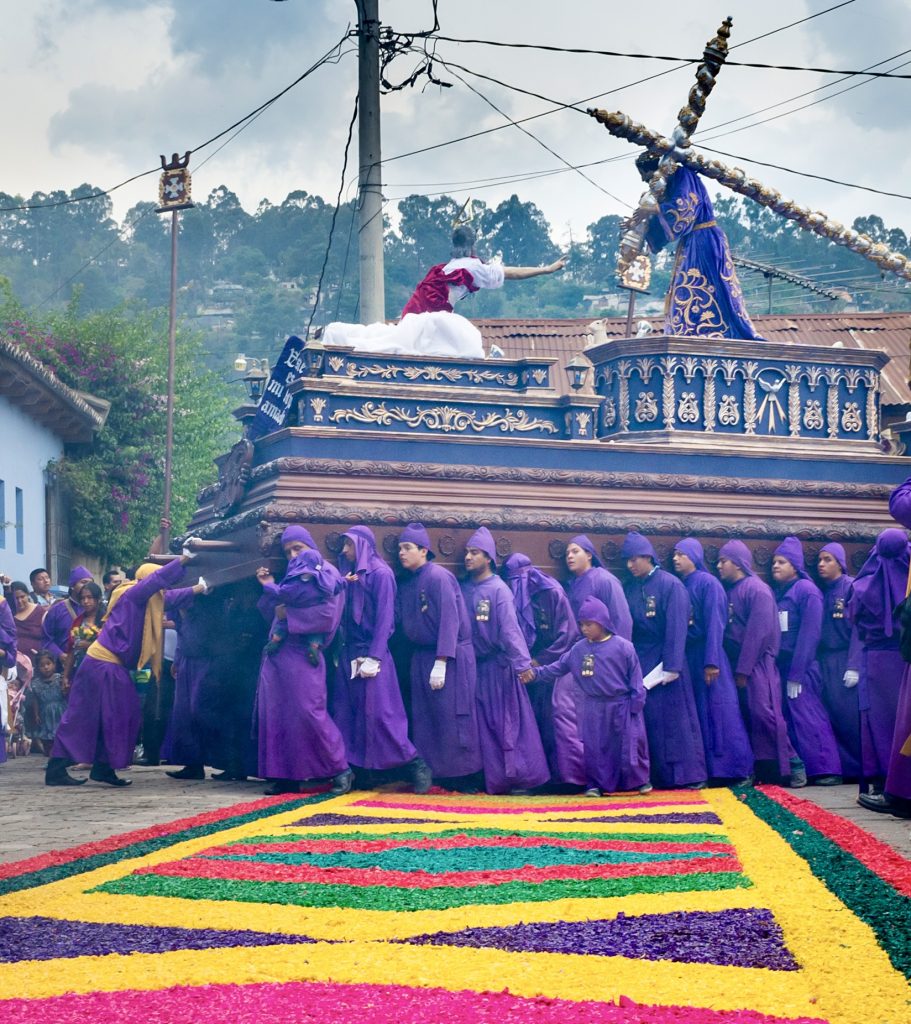
The importance of Holy Week in Antigua Guatemala is reflected in the grand preparations that take place in the weeks leading up to the event. Artisans spend months designing the intricate carpets and working on the floats. Locals gather to plan and participate in the various processions and ceremonies.
Semana Santa in Guatemala Declared Intangible Heritage of Humanity by UNESCO
In February of 2023 Guatemala’s Semana Santa, also known as Holy Week, was recognized as an intangible heritage of humanity by UNESCO. The event showcases the cultural diversity and extraordinary richness of Guatemala’s traditions, including processions, vigils, funeral marches, seasonal cuisine, and the creation of beautiful carpets, gardens, and altars.
This recognition emphasizes the importance of passing down knowledge and skills from one generation to the next. It’s a time of solemnity, joy, union, coexistence, and fraternity in Guatemala. This distinction shows the commitment to preserving and protecting the cultural activities that are part of the tradition of Semana Santa in the country. Various international delegations appreciated the synergy between the Catholic faith and various symbols that stand out in Guatemala during Semana Santa, like the colorful carpets, processions, and representative elements among others.
Semana Santa is celebrated by the people of Guatemala in every corner of the country, but nowhere is this even more magnificent than in the colonial city of Antigua. Here the gorgeous carpets made of flowers, sawdust and fruits that cover the cobblestone streets are fantastic works of art. The floats carried during the processons there are immense, reaching up to 18 meters long and needing about 80 men to cary them.
Semana Santa in Antigua Guatemala
Antigua Guatemala is a captivating city that was founded during the 16th century by Spanish colonialists, and is now recognized as a UNESCO World Heritage Site. This charming city is also home to one of the most breathtaking Easter traditions in the world. The Semana Santa events in Antigua Guatemala combine indigenous traditions with Catholic customs to create a unique and memorable experience.
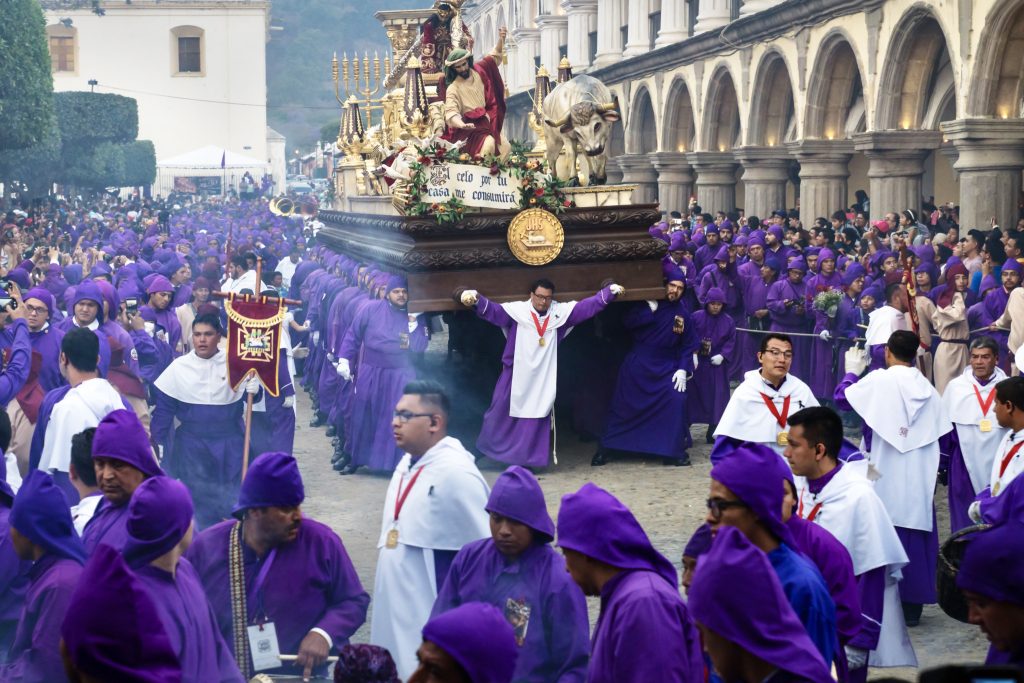
During Holy Week, locals and visitors alike are treated to an impressive display of creativity and devotion as revelers walk on elaborately stenciled “carpets” made from dyed sawdust, flowers, and pine needles. These intricate carpets, known as alfombras, are created on the streets and are often several blocks long, with vivid and colorful designs that depict religious scenes. Seeing the processions and the carpets with Antigua Guatemala’s colonial ruins in the background is a magical and amazing experience.
The creation of alfombras is a highly skilled and time-consuming process that involves months of planning and preparation. Families and community groups work together to design and execute the carpets, using a variety of natural materials to create stunning designs. The process is both a spiritual and cultural experience, as people come together to honor their faith and showcase their artistry.
Throughout the Semana Santa celebrations, the streets of Antigua Guatemala are alive with the sounds of music, the smell of incense, and the colorful displays of traditional attire. It is a time when the entire community comes together to celebrate their faith and culture, making it a truly special event.
Cultural Elements of Semana Santa in Guatemala
Semana Santa, or Holy Week, is a time of deep religious significance in Guatemala. During this week-long observance, many communities across the country come together to participate in a variety of cultural and religious traditions. These traditions, which have been passed down through generations, are an integral part of the country’s cultural heritage and offer a unique insight into the history, beliefs, and customs of Guatemala.

From elaborate processions and colorful decorations to traditional foods and music, the cultural elements of Semana Santa in Guatemala are diverse and vibrant, and play a significant role in shaping the identity of this fascinating country. In this article I will share some of the key cultural elements of Semana Santa in Guatemala, and how they contribute to the rich tapestry of this important cultural event.
La Velacion: The Vigil
Growing up in Guatemala, I have experienced the magical Holy Week celebrations in La Antigua and the surrounding villages firsthand. The Velaciones, or Holy Vigils, are a significant part of these celebrations that ornament the churches throughout Cuaresma, which is the period of Lent leading up to Easter.
Each parish’s brotherhood, known as an hermandad, takes charge of organizing their church’s velación, displaying their religious processional statue in front of or near the main altar. The velación is a grand display that is carefully curated with a biblical or allegorical scene created using the parish’s processional image of Jesus, other statues, and additional props. The backdrop is designed to be eye-catching and thought-provoking, inviting worshippers and visitors alike to reflect on the story and message behind it.
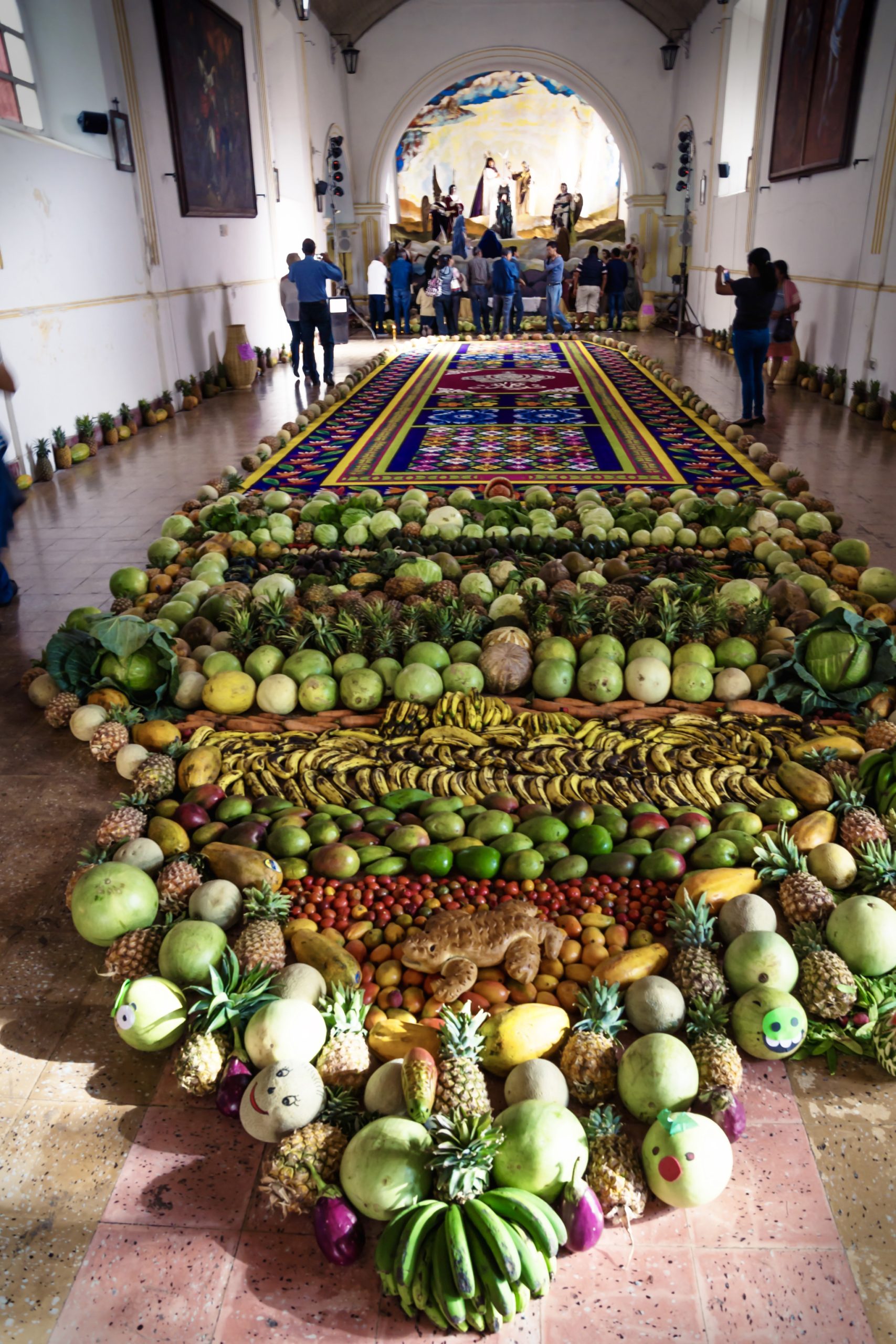
One of the most impressive features of the velación is the vibrant handmade alfombra, which is a carpet made of brightly dyed sawdust that lies at the foot of the display. The alfombra is a true work of art, with intricate designs and vibrant colors that showcase the artistic skill of the community. In addition to the alfombra, there is also a huerto, which is a garden display made of a beautiful combination of flowers, fruits, vegetables, bread, candles, and a large native seed pod known as the corozo, which has a unique odor that is traditionally evocative of Cuaresma.
The Carpets: Antigua’s Sawdust Alfombras
The intricate and artistic carpets that cover the cobble stone streets of Antigua during Semana Santa are made using aserrín or viruta dyed in bright colors, along with flowers like bougainvillea, chrysanthemums, carnations, and roses, and even fruits and vegetables. Local residents spend hours creating these stunning works of art to decorate the procession route.
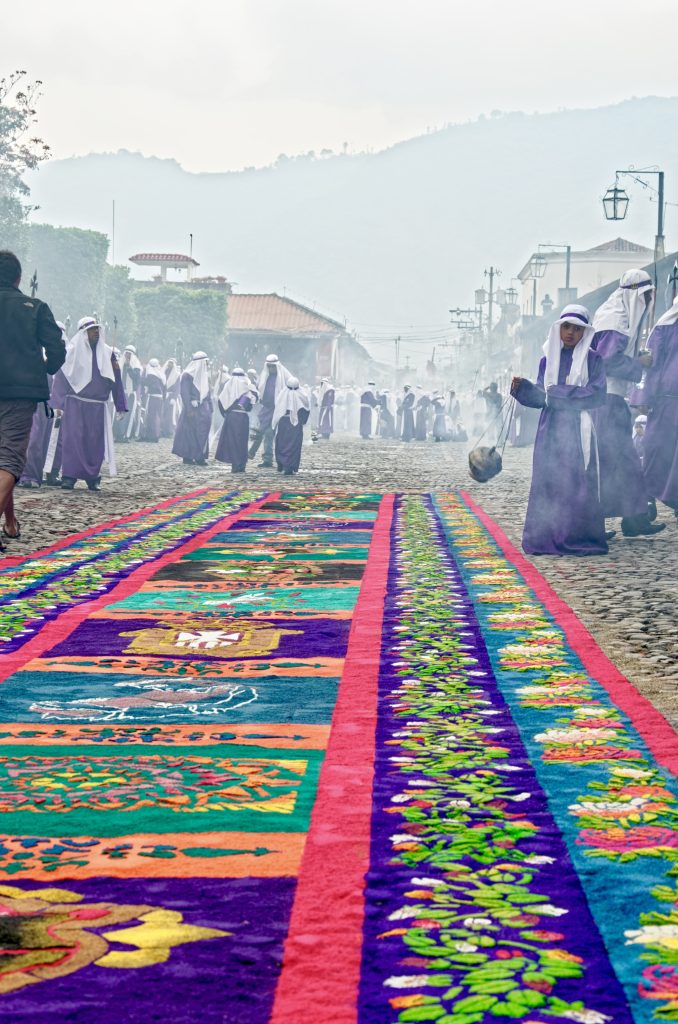
Skilled artists use stencils to quickly create carpets that can be up to half a mile long, depicting different scenes important to the creators, including religious imagery, Mayan traditions, mother nature, and Guatemalan history. As the procession makes its way down the street, the cucuruchos carrying the andas shuffle their feet over the carpets, blending the colors and ultimately destroying the alfombras.

But the purpose of the carpets is not to last forever; rather, they serve as a temporary and beautiful tribute to the procession. Immediately following the procession, a team of cleaners moves through the streets, sweeping up the sawdust and erasing all signs of the intricate carpets. This tradition, which combines Indigenous rituals and Christianity, has been present in Central America for around 400 years, and has become especially notable in Antigua, Guatemala.
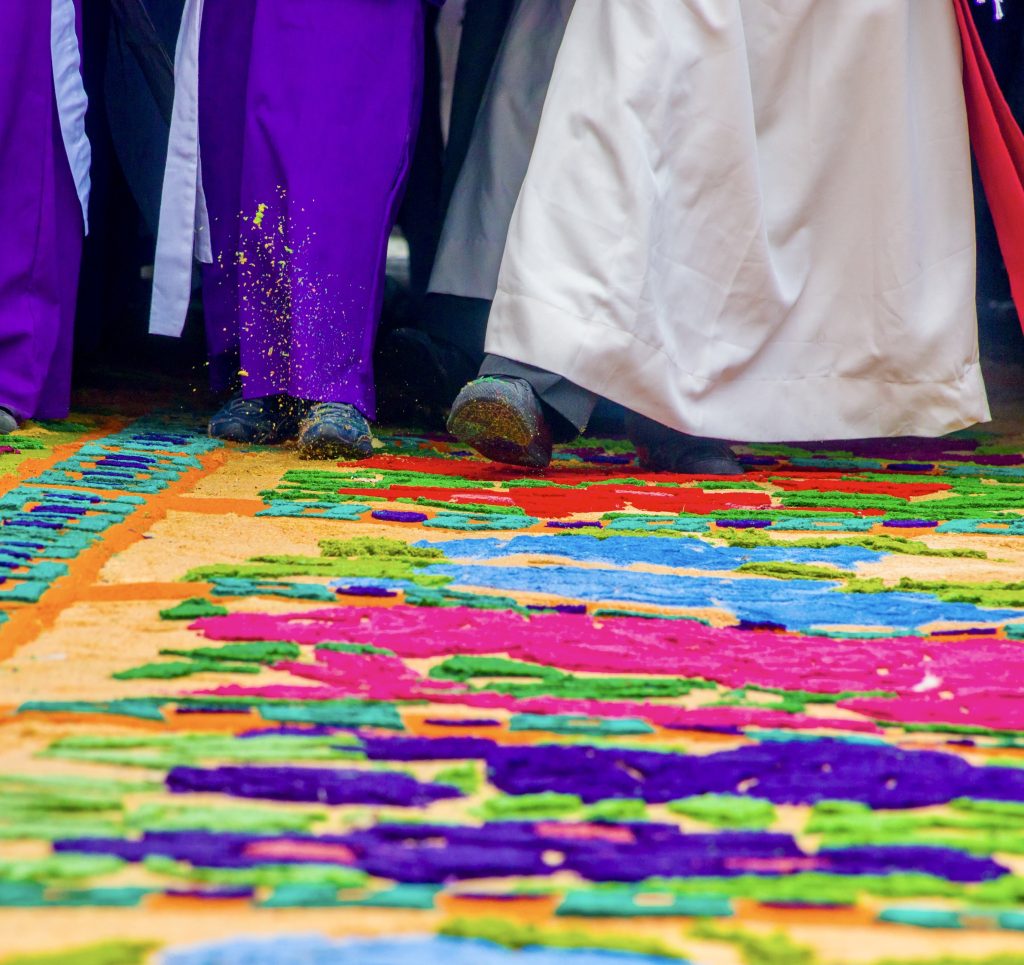
My mom had a house in Antigua and they would spend most of the week there once my stepdad retired. Every Semana Santa the entire block would get up early to create an alfombra using flowers and I participated a few years. I would pick up flowers from our own back yard to use and to this day this is a memory I dearly cherish. It brought the community together and was such a wonderful experience to be part of. If you’re visiting Guatemala for Easter you can book a hotel
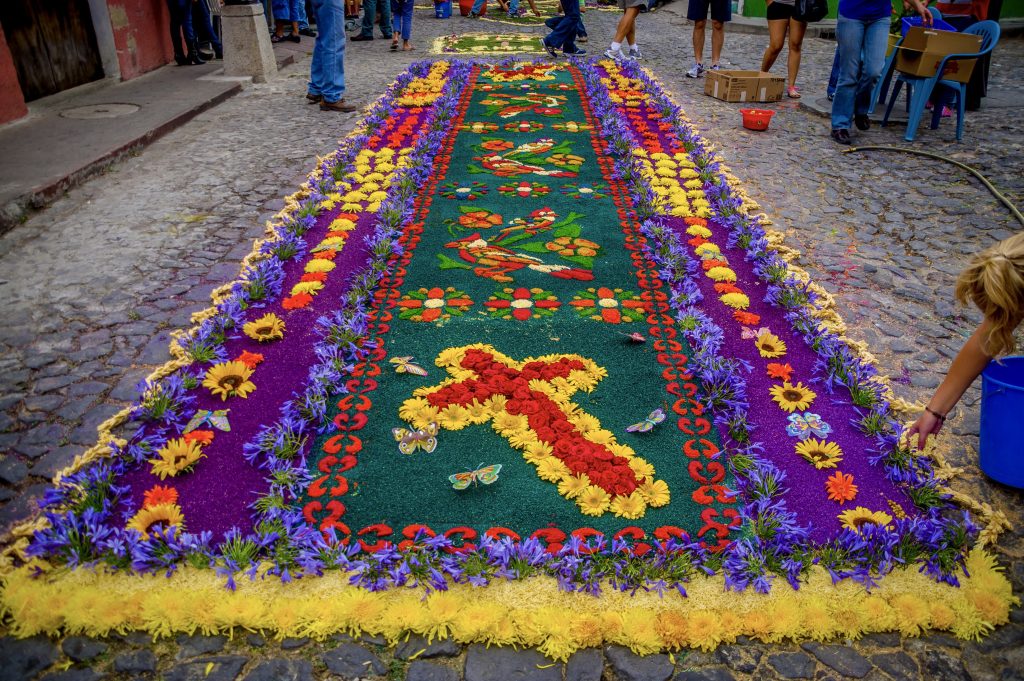
The Cucuruchos
During the processions, the “cucuruchos”, men dressed in purple tunics and hats, take turns carrying large floats that can weigh as much as a bus. Despite the heavy labor, the penitents pay for the privilege as a show of their devotion to the Catholic faith.
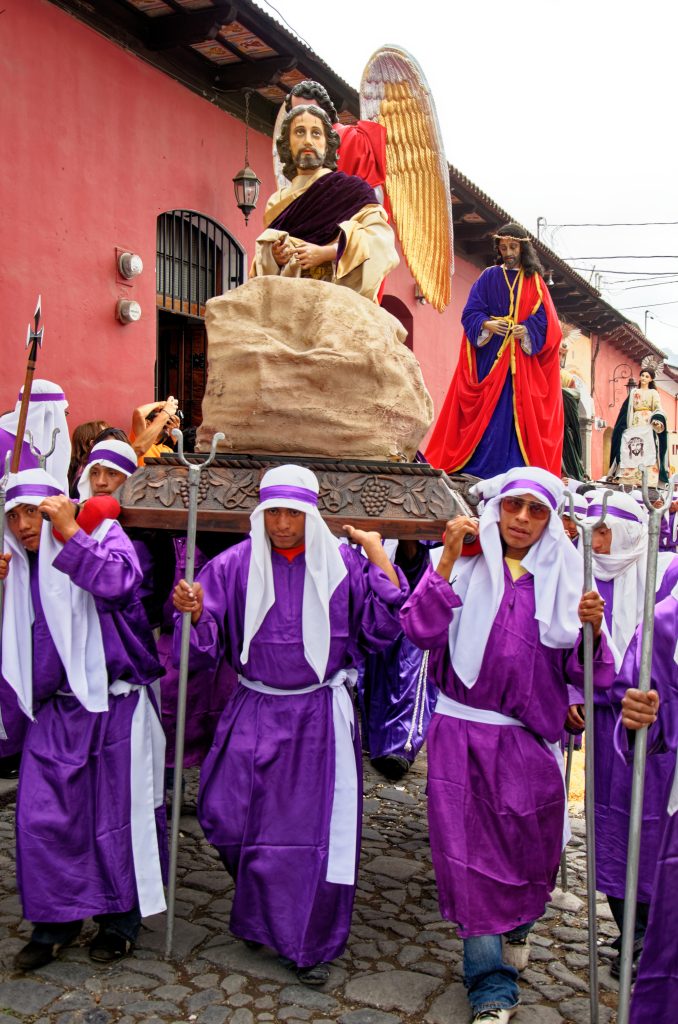
During Semana Santa the city is filled with cucuruchos. They congregate in groups in the corners waiting for their turn or sit in the park eating a quick meal before they have to go back to carrying the floats. Their presence, along with the somber music and the smell and incense and corozo turns the entire city into a mystical and solemn scene.
Women also participate in the processions as “dolorosas” or “cargadoras,” carrying smaller floats of the Virgin Mary. The women wear black skirts or dresses and a mantilla, a type of head-covering made of lace.

The “cucuruchos” are an important part of Holy Week celebrations in Guatemala, as they are Catholic worshippers who participate in processions to prove their faith. The purple clothing they wear symbolizes their religious penance. On Good Friday, the outfit changes to black after 3:00 pm as a sign of mourning for the death of Jesus Christ.
The tradition of wearing these outfits dates back to the 12th century when they were worn by pilgrims on their way to Rome and Santiago de Compostela. The outfits were introduced to Guatemala by Spanish conquistadors around 1550 and have changed very little since then.
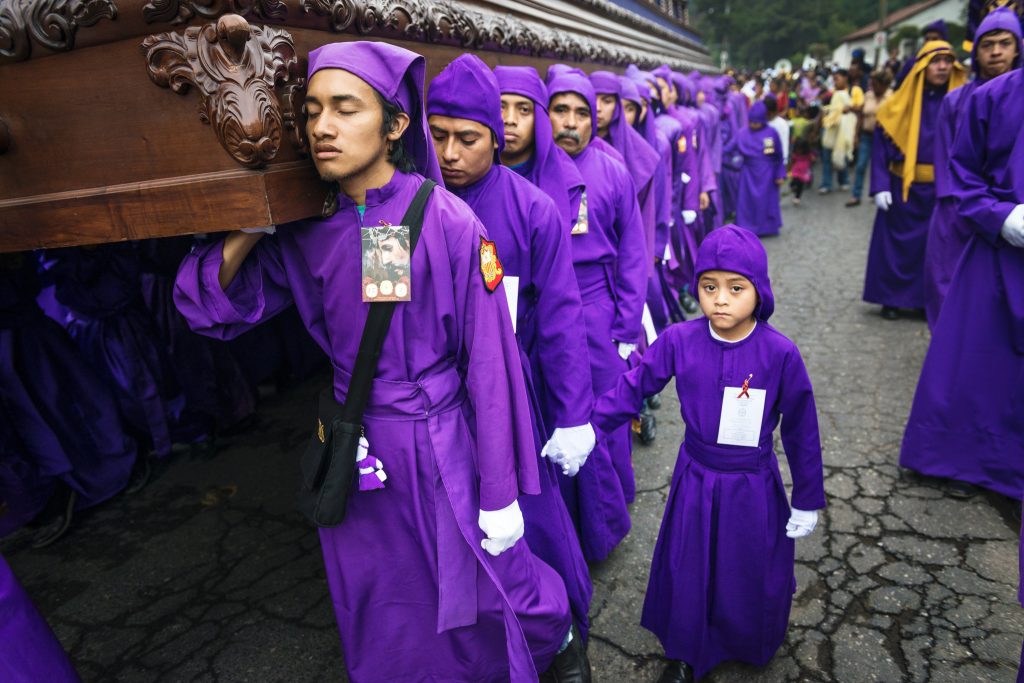
Although there may be some degree of social status involved in participating, the principal motivation for the “cucuruchos” and “dolorosas” remains a display of their devotion to their catholic faith. In many instances the tradition of being a cucurucho is passed on from generation to generation. You will often see cucuruchos carrying the andas with their children (also dressed in the purple robes). There are also processions that are specifically for the younger devotees and are carried by children and teens.

The Processions in Guatemala
The Procesiones are one of the most important and integral part of the Semana Santa festivities. They are steeped in religious and cultural significance and are carried out with great devotion and pageantry.
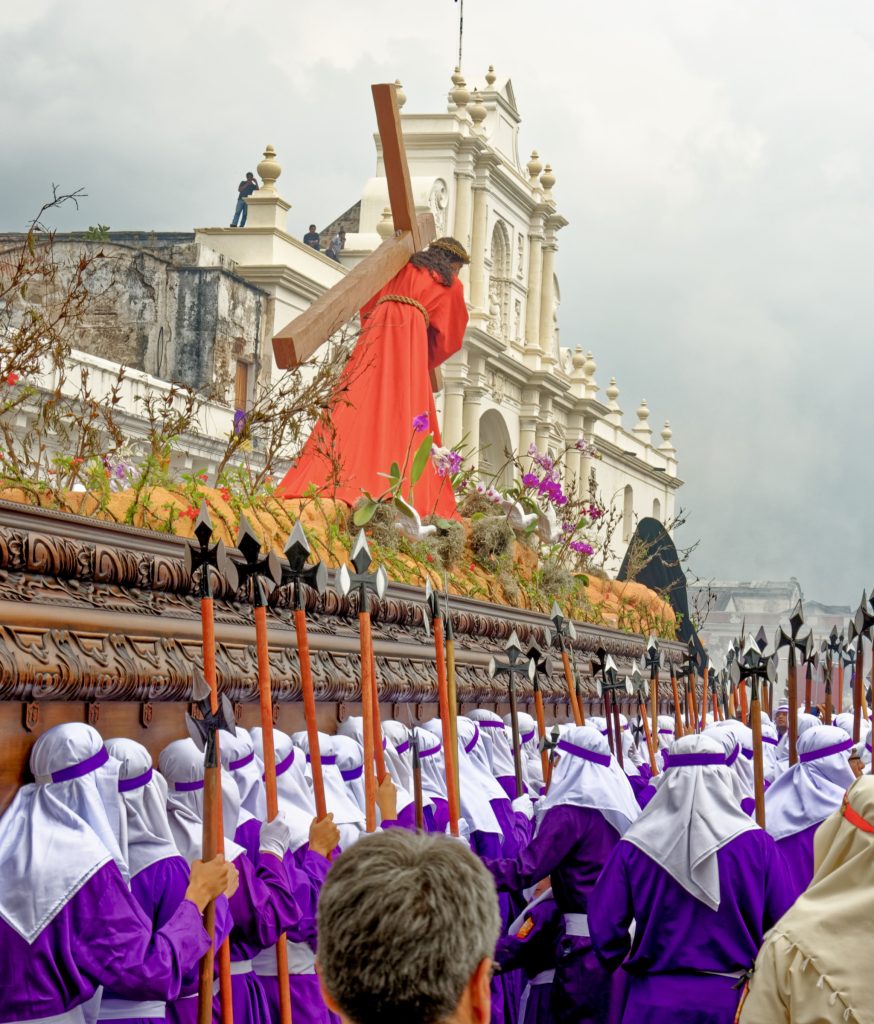
The procession usually begins with men dressed in elaborate Roman Centurion costumes, symbolizing the role of the Romans in Jesus’ crucifixion. They lead the procession, followed by incense carriers and banner carriers. The central attraction of the procession is the anda, a large and ornately decorated wooden platform bearing the parish’s religious processional sculpture of Jesus. Some of the andas are as big as a bus, and Guatemala holds the record for the largest procession, the and of the Cristo Yaciente del Calkvario in Guatemala City. The float is over 80ft long, weighs about 2,500 pounds and is carried by 140 people who changing shifts every block.Many of these sculptures were created during the Spanish colonial period, and they are revered as sacred objects.Se
The anda is carried on the shoulders of cucuruchos, who wear full-length tunics in purple until 3 PM on Viernes Santo (Good Friday), after which they switch to black. These carriers are an essential part of the procession, and they are highly respected for their strength and devotion to their faith.
As a Guatemalan, I have always been struck by the beauty and solemnity of the Procesiones. They are a testament to the deep religious and cultural roots of my country and a reminder of the sacrifices that Jesus made for us. Participating in these processions is an honor and a privilege, and I feel grateful to have experienced them firsthand.
The Meaning of the Music during the Semana Santa Processions
In Antigua, Guatemala, the music in the processions during Cuaresma and Semana Santa is plays a very important part. I’ve been to many processions and it feels really humbling and solemn to listen to the banda (band) as the procession approaches. The music seems to bring the whole experience of watching or participating in the procession together and provides the backdrop for the deeply moving processions as they slowly move along the streets carried by the cucuruchos or the dolorosas. The music is played by different instruments like the tsijolaj and tambor, which symbolize the beginning of the procession. The marching band accompanies the procession by playing marchas fúnebres (funerary music).
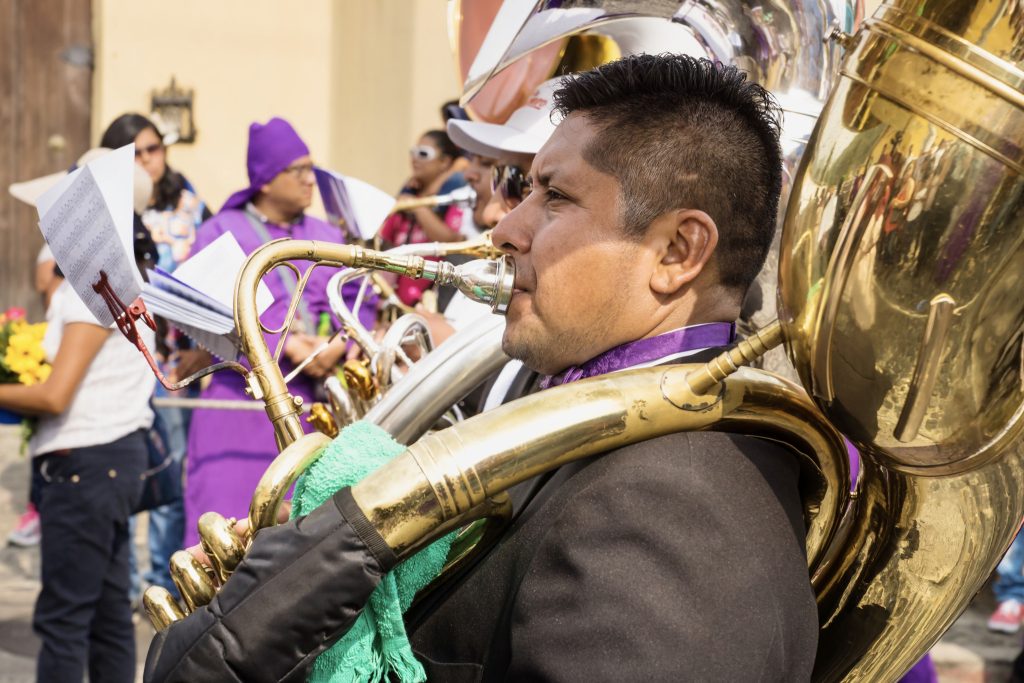
The marchas fúnebres have a specific style that’s sad, slow and has a heavy sound. They’re played by different instruments like timpani, drums, clarinets, trumpets, and other wind instruments. They have a deep significance to the people of Antigua because they’re associated with the religious time of Cuaresma and Semana Santa. They’re connected to the life of Jesus Christ and dedicated to religious icons or experiences. When people carry the icons, the music evokes and strengthens their emotions, making the music even more powerful.
Traditional Guatemalan Foods for Semana Santa Celebrations
Guatemalan cuisine is a fascinating blend of pre-Hispanic and Spanish ingredients and techniques, and this is especially evident in the savory traditional dishes and Guatemalan desserts consumed during Cuaresma and Semana Santa. Many of these recipes have been handed down from one generation to the next, and they are often treasured family secrets due to their unique techniques and ingredients.
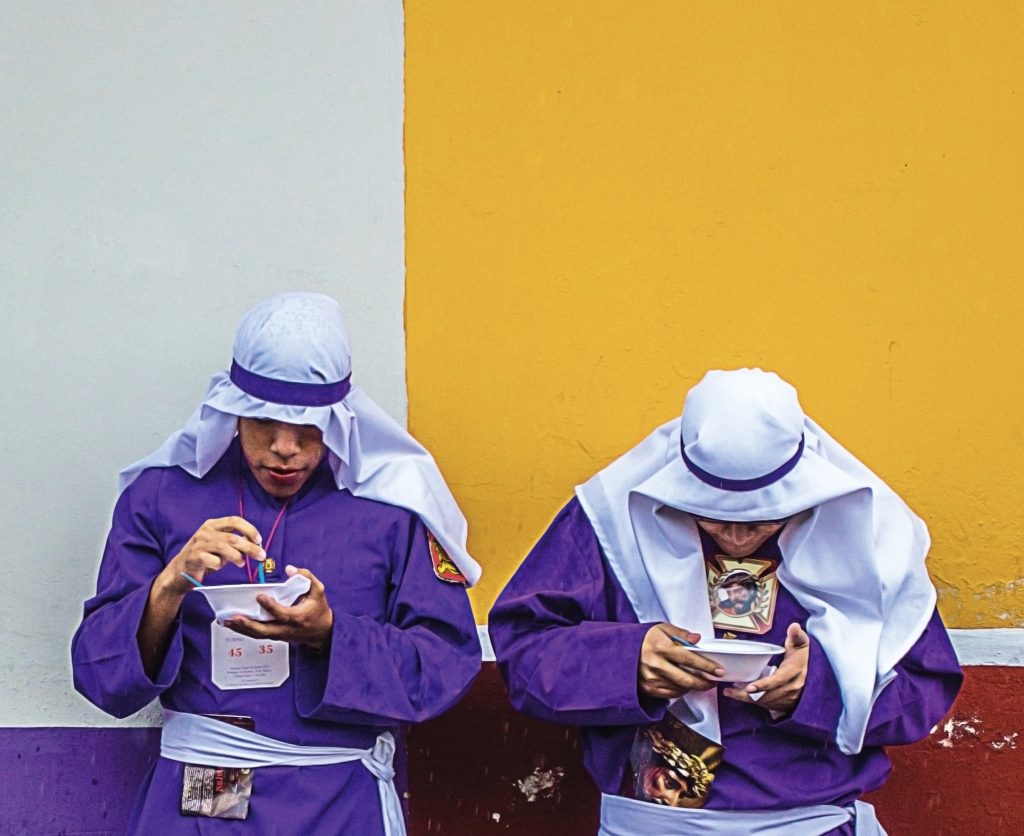
Traditional Guatemalan Foods for Lent
These ancestral recipes reflect the rich cultural heritage of Guatemala, which has been shaped by indigenous, Spanish, and other cultural influences. While some of these dishes, such as bacalao a la Vizcaina have stronger ties to Spanish culture some others like the tamalitos de elote have a stronger connection to Mayan cuisine.

Cuaresma and Semana Santa are times of reflection and spiritual renewal for Guatemalans, and traditional foods play an important role in these celebrations. One of the most popular dishes is , bacalao a la Vizcaina a dish made with salt cod, potatoes, onions, peppers, and tomatoes, which is often served on Good Friday. Tamalitos de viaje and tamalitos de elote are also a popular food during Semana Santa, small tamales that are easy to carry on the go.
Guatemalan Desserts Popular During Easter
For dessert, Guatemalans often enjoy garbanzos en miel, a sweet dish made with chickpeas, cinnamon, cloves, and piloncillo (unrefined cane sugar), or empanadas de manjar, sweet turnovers filled with a sweetened milk custard. Another popular sweet treat during Semana Santa is torrejas, a type of French toast made with a cinnamon-infused syrup. One of my favorite desserts are the delicious jocotes en miel, a small fruit in sweet syrup.

Traditional Guatemalan Drinks
To wash down these delicious dishes, Guatemalans often enjoy a refreshing drink. A popular one is fresco de chilacayote. This sweet beverage made with chilacayote, a type of squash that is boiled with cinnamon, cloves, and sugar, and then blended with water. Other popular drinks during Semana Santa include fresco de súchiles, and horchata, a sweetened rice milk drink flavored with cinnamon. All of these traditional foods and drinks are a cherished part of Guatemalan culture. They add to the festive atmosphere during Semana Santa.

Whether prepared at home or sold on the streets, these dishes offer a taste of the unique and complex history of Guatemala. It is no wonder that the preparation and consumption of these dishes during Cuaresma and Semana Santa are such an important part of Guatemalan culture.
Other Guatemalan Articles
Antigua Guatemala Travel Guide: The Best Tips From A Local
Folk Dances In Guatemala: Their Meaning, History And Where To See Them
Guatemalan traditional dances are a vibrant expression of the country’s rich cultural heritage, blending ancient rituals with colorful storytelling. Here you will find the most popular danzas folcloricas or folk dances in Guatemala. I will be sharing each dance’s significance in Guatemalan traditions, it’s history as well as the when and where you can see each of these dances from el baile del Venado and La Conquista to the popular baile de Moros y Cristianos, the Palo Volador, the Rabinal Ajau and many more.

Antigua Guatemala Festivals, Celebrations And Important Dates
